Condition Monitoring in the 21st Century
Sandy Dunn
Introduction
While the National Manager for one of Australia’s largest Condition Monitoring service providers, I initiated a strategic review of the Condition Monitoring marketplace in order to identify and assess the changes occurring within the industry, and the opportunities and threats that these changes represented to our organization. Unfortunately, the review was not completed before I left that organization, but this paper reflects the findings from that review at the time that I left, supplemented by further research and consultation with key players in the industry.
In this paper I will outline some of the key business opportunities and issues which are driving change in the industry, summarize some of the resulting trends, as I see them, and then draw some conclusions regarding the implications of these trends for Condition Monitoring equipment manufacturers and suppliers, Condition Monitoring contractors, and organizations employing Condition Monitoring techniques.
The focus of this paper is on Vibration Monitoring technologies, but many of the issues, opportunities, trends and implications are similar across the other areas of Condition Monitoring technology.
Condition Monitoring Defined
Before we start, we should ensure that we all have the same understanding of the definition of the term Condition Monitoring. In the context of this paper, Condition Monitoring is taken to mean the use of advanced technologies in order to determine equipment condition, and potentially predict failure. It includes, but is not limited to, technologies such as:
- Vibration Measurement and Analysis
- Infrared Thermography
- Oil Analysis and Tribology
- Ultrasonics
- Motor Current Analysis
Condition Monitoring is most frequently used as a Predictive or Condition-Based Maintenance technique. However, there are other Predictive Maintenance techniques that can also be used, including the use of the Human Senses (look, listen, feel, smell etc.), Machine Performance Monitoring, and Statistical Process Control techniques. These would not be considered to be Condition Monitoring for the purposes of this paper.
Asset Effectiveness: The Driver for Change in Condition Monitoring
I present this paper with a great deal of apprehension. My anxiety stems from two sources:
1. Predicting the future is fraught with danger. Many wiser heads than mine have made bold predictions of the future, only to be proved hopelessly wrong.
2. The title of this paper Condition Monitoring in the 21st Century is a tad presumptuous, especially when we consider that the field of Condition Monitoring was only established with any significance within the last quarter of the last century.
Nevertheless, I take the view that whatever changes occur within the field of Condition Monitoring will, in the long run, only be sustained if they successfully address real business needs. In this area, Condition Monitoring has a long way to improve, if you believe the results of research from the USA. Repeated surveys by Plant Services Magazine in the USA have led to very similar findings that:
- “Organizations are reluctant to invest in new manufacturing technologies because they and their management aren’t convinced of the return on investment (ROI)”
- In a survey of 500 companies, less than 3% of respondents were able to achieve a measurable return on their investment in Predictive Maintenance technologies
So what is the business need that will drive sustainable change in Condition Monitoring in the new century?
In my view, the business need that is likely to dominate the industrial maintenance scene, at least for the first part of this century, is Asset Effectiveness – the need to extract maximum profits from the minimum investment in plant and equipment. How do we achieve this through the use of Condition Monitoring technologies? In one of five ways:
- By improving Equipment Reliability through the effective prediction (and then avoidance) of equipment failures
- By minimizing downtime through the integrated planning and scheduling of repairs indicated by Condition Monitoring techniques with those indicated by other techniques.
- By maximizing component life by avoiding the conditions that reduce equipment life (for example, by ensuring ongoing precision alignment, minimal lubricant contamination etc.)
- By utilizing Condition Monitoring techniques to maximize equipment performance and throughput
- By minimizing Condition Monitoring costs
I would argue that the size of the benefits on offer to an organization by utilizing Condition Monitoring techniques in each of the ways outlined above varies, depending on where, on the continuum from Innocence to Excellence, that particular organization is.
The Journey to Operational Excellence may be represented as illustrated below:
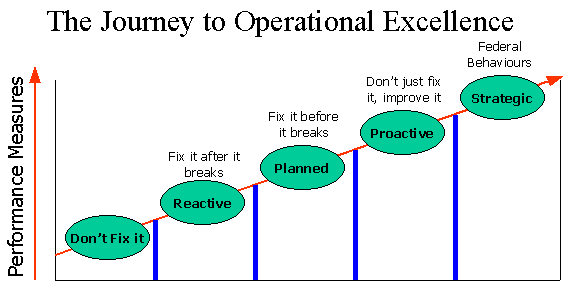
At the extreme left hand side of the chart, you could consider that Maintenance is at a level of “Innocence” – at the extreme right hand side, it is at the “Excellence” level.
Business Need 1 – The need to predict equipment failures
The key thing to note from this chart is the different focus of maintenance at each of the stages on the journey. When in the Reactive mode, the motivator for improvement is the need to avoid failures. In terms of Condition Monitoring, this means that the primary use for Condition Monitoring is to predict (and therefore assist in avoiding) unplanned equipment failures. The benefits of using Condition Monitoring in this way are significant, when you are predominantly operating in a reactive maintenance mode (or even predominantly in a traditional “fixed-interval, time-based” mode of preventive maintenance).
It is probably safe to say that most organizations with a significant capital investment in plant equipment are, these days, employing some form of Condition Monitoring technology in order to predict at least some failures. However it is highly likely that the frequency at which monitoring is taking place is far from optimal. Reliability Centered Maintenance (RCM) principles have taught us that the primary determinant of frequency of a Condition Monitoring task is the lead time to failure, or PF Interval. In plain English, this is the time from which an incipient failure can first be detected, until functional failure occurs. For example, the time interval from when overall bearing vibration levels reach an “alarm” limit, until the bearing seizes completely. In order to be completely sure that the failure is detected prior to the functional failure occurring, the bearing must be monitored at a frequency less than the PF Interval. So far so good – in theory. Unfortunately, the practice is that the PF Intervals for sophisticated Condition Monitoring techniques are highly variable. For example, for Vibration Analysis on a bearing, the PF Interval will vary depending on the type of failure detected, the type of bearing installed, the severity of its operating cycle, the type of lubrication applied, ambient temperature conditions and many other factors. To date, no Condition Monitoring organization can give anything but the most approximate estimate of the PF Interval. Any error tends to be on the conservative (i.e. too frequent) side. But nevertheless, I could quote many examples of bearing failures that have occurred undetected, despite these bearings being monitored at these conservative frequencies.
To date, little concerted effort has been made to attempt to improve the accuracy of PF Interval estimation for Condition Monitoring technologies. But as business becomes less tolerant of equipment failures, and more insistent on obtaining value for money for their investment in Condition Monitoring technologies, there will be increasing pressure for development of a more sophisticated method for the accurate estimation of the PF Interval.
Business Need 2 – The need for a holistic view of equipment condition
However, there are other means in which Condition Monitoring can assist in improving maintenance during this “Planned” Maintenance phase. As previously mentioned, opportunities exist to minimize total equipment downtime by taking a holistic view of plant condition, and combining planned maintenance tasks, wherever possible, into a single equipment shutdown. For example, if Vibration Analysis indicated that a bearing failure on a particular pump was imminent, wouldn’t it be preferable to be able to assess the condition of all the other components of the pump (impeller, seals, backplate etc.) in order to determine whether any of these items should be replaced or refurbished at the same time as the bearings?
Traditionally, this assessment has been left until the pump has already been shutdown, and the pump disassembled, at which time the tradesperson performing the repair makes an assessment of what additional internal parts are required. If these are required, then there is a delay while the parts are requisitioned and delivered to the repair site (or not, as the case may be if the parts are not readily available). Alternatively, the parts are requisitioned “just in case”, and the tradesperson feels some pressure to use those parts, rather than return them to store. In either case, this process leads to increased downtime, and potentially, to unnecessary parts usage.
A holistic view of equipment condition requires the effective integration of:
- Condition Monitoring inspection results (including all Condition Monitoring techniques used – Vibration Analysis, Oil Analysis, Thermography etc)
- Visual inspection results
- Fixed-interval “Preventive” maintenance actions, and
- Equipment performance monitoring
This integration is made more difficult because the data in each of these areas has traditionally been kept in different information systems. The Condition Monitoring data has been stored in one or more Condition Monitoring software packages. Visual Inspection results are often stored on manually recorded checksheets, “PM” details have been stored in the CMMS, and equipment performance data (if available at all) is stored in the Process Control System.
Business Need 3 – The need for greater accuracy in failure prediction
Even if we do not take a completely holistic approach to equipment condition, there are still significant benefits to be had from integrating process control data with Condition Monitoring data. For example, it is known that certain electric motors will display higher vibration when operating under low loads, than when they are operating under high load. Yet in the traditional methods of Vibration Analysis, using periodically collected data, using a hand-held data collector, these variations are not effectively taken into account, except perhaps in a qualitative manner. Slight variations in vibration results from one survey to the next are assumed to be due to “process conditions”, and regarded as not significant. If we were able to collect relevant quantitative data regarding the “process conditions” existing at the time that the vibration data was collected, and correct the vibration data for these conditions, then our diagnostic capability would become far more accurate and sensitive. At present, this is not the case. Analyst experience becomes, therefore, more important in arriving at accurate fault detection and failure prediction.
In order to achieve greater integration, we need integration of these data sources, or at the very least, we need each of these systems to be able to interface with one another using common standard protocols. We have recently seen Condition Monitoring suppliers such as CSI, Predict-DLI and others offer integrated Condition Monitoring software, which permits the effective integration of Oil Analysis, Vibration Analysis and other Condition Monitoring data into combined reports. We have also seen an increasing number of CMMS vendors include a “Condition Monitoring” module within their software. However, we are yet to see an effective solution that integrates these two solutions into an effective whole.
As far as the integration of Process Control Data with Condition Monitoring data is concerned, there are standards such as OLEPC (Object Linking and Embedding for Process Control) that vendors such as Predict-DLI are actively supporting. However this is primarily being used to allow high vibration alarms on permanently monitored equipment to be displayed on Operators’ control panels (or more accurately, computer screens). Honeywell are currently conducting trials to use equipment performance data collected within their process control systems in order to optimize and maximize total system performance, however this does not currently use equipment Condition Monitoring data to any great extent.
Part of the reason for this is technical. Current commonly used sensor technology only permits the most rudimentary form of signal processing and analysis within the sensor. In the case of Vibration Analysis, in order to perform accurate and detailed failure prediction, this means that large quantities of data must be transmitted from the sensor to a separate (usually hand-held) data collector for subsequent processing and analysis. If permanent, on-line vibration monitoring is required, then at present, for anything other than an overall vibration alarm, the cost of providing the required communications infrastructure and the data collection and analysis equipment far outweighs the benefits to be obtained.
But Moore’s Law applies here. The good news is that the costs of increased “on-board” signal processing power are decreasing dramatically. Some equipment vendors already provide permanently installed vibration sensors in some of their larger electric motors and other equipment. Wilcoxon Research has already developed so-called 4th generation “Smart Sensors” that permit onboard signal processing and analysis, similar to that currently requiring a hand-held data collector and/or a Personal Computer. The bad news is that this technology is still too expensive to be economic in most industrial applications.
However, when fully implemented, this smart sensor technology will greatly reduce the complexity of linking the outputs of these sensors to current Process control systems. More and more equipment will be able to be monitored continuously, on-line, and control room operators will be able to tell, quickly and easily, the current condition of the bearings or alignment or balance or gears on a particular machine.
Business Need 4 – The need to reduce the cost of Condition Monitoring
Note that, however, to be successful, the algorithms that are used onboard these smart sensors must be both accurate and reliable in assessing equipment condition and predicting equipment failure. In the early days of vibration analysis, accurate diagnosis of equipment failure was largely dependent on the skill and experience of individual analysts. However, with the development of more effective Vibration Analysis software, the reliance on a highly skilled analyst has reduced. While individual skill is still important – particularly for more complex problem-solving – the capability of vibration analysis software to generate trends, as well as various forms of user-set alarm levels, has made the “first pass” assessment of whether a problem exists or not somewhat easier.
Some vendors also offer so-called “expert” systems for fault diagnosis. At present, these expert systems are still essentially rule-based systems, and like all rule-based systems, the results are only as good as the rules that have been established within the system. The reality is that these rule-based expert systems are still significantly weaker than even a moderately experienced vibration analyst in identifying and diagnosing faults. Nevertheless, an imperative, if smart sensor technology is to work, and if widespread on-line vibration monitoring is to proliferate, is the development of better, and more accurate, “expert” software. Look to see further advances through the use of fuzzy logic and neural network processes in Condition Monitoring software.
The impact of these improvements in failure diagnosis software will be two-fold. First it will improve the consistency and accuracy of failure diagnosis. Second, it will reduce the labour required to assess equipment condition. Some organizations already use fairly rudimentary “first-pass” vibration or oil analysis conducted by plant operators in order to determine whether a problem exists with a particular item of equipment. Only once a problem has been identified, does the Condition Monitoring technician become involved in conducting a more detailed analysis and diagnosis. With the advent of more sophisticated condition assessment software, I would expect this practice to become more widespread.
Business Need 5 – The need to improve equipment and component reliability
Once an effective planned and predictive mode of maintenance has been established within an organization, the next opportunity for improvement is by progressively extending the Mean Time Between Failures for that equipment. While this can be achieved by modifying equipment or components, or replacing them with more reliable items, a major opportunity for improvement exists by improving the precision with which maintenance is performed.
Condition Monitoring can assist here in a number of ways.
Taking Vibration Analysis as an example, it should first be recognized that there is a strong negative correlation between the overall vibration level for a bearing, and the expected life of that bearing. Put simply, the higher the overall vibration level to which the bearing is subjected, then the shorter the expected life of the bearing.
Second, it should be recognized that bearing vibration can be induced by applying cyclical forces from two sources, either:
- From forces originating within the bearing (e.g. those due to impending bearing failure), or
- From forces applied to the bearing from external effects.
Ignoring the first of these causes, for the moment, cyclical external forces can be applied to the bearing in a number of ways, such as due to:
- Misalignment
- Improper bearing installation
- Rotor imbalance
- Pump cavitation
- Flow induced vibration
- Etc.
It is clear, therefore, that increases in vibration due to these externally imposed forces can significantly reduce bearing life.
Traditionally, Vibration Analysis has consisted of assessing the vibration levels, and then comparing these with some (usually fairly arbitrarily determined) warning or alarm levels, above which some corrective action is required. With there being a strong correlation between vibration levels and equipment or component life, we need a more rigorous method of determining what those alarm levels should be. This will require consideration of such factors as:
- Bearing design and capability
- The consequences of bearing failure (in terms of increased costs, lost production, safety or environmental impact etc.)
- The cost trade-off between more frequent, and more rigorous monitoring, and improved component or equipment life
- Underlying process conditions
This will require an additional level of sophistication above and beyond that which is currently being applied by Condition Monitoring practitioners.
Business Need 6 – The need to optimize equipment performance
There have been several articles written about the use of performance monitoring on steam turbines, using measurements of temperature, pressure, power output and other techniques to determine turbine condition, and the specific faults that may require attention. It is likely that this type of monitoring will become more widespread on large equipment. Large Diesel engines, pumps and other sophisticated equipment may also be able to be monitored using similar principles. Expect to find work being done to increase the sophistication of techniques such as ultrasonic flow measurement to assist with the cost-effective application of performance monitoring techniques to a wider range of equipment.
7 key trends for Condition Monitoring in the 21st Century
Summarizing the key trends deduced from the above analysis, we should expect to see:
- The development of smart sensors, and other low-cost on-line monitoring systems that will permit the cost-effective continuous monitoring of key equipment items
- The increasing provision of built-in vibration sensors as standard features in large motors, pumps, turbines and other large equipment items
- Increasingly sophisticated condition monitoring software, with rapidly developing “expert” diagnosis capabilities
- The acceptance of Condition Monitoring within the “mainstream” of Operations and Maintenance, with Production operators increasingly utilizing Condition Monitoring technologies as part of their day-to-day duties
- Increasing integration, and acceptance of common standards for interfacing Condition Monitoring software with CMMS and Process Control software
- An increasing focus on the business implications and applications of Condition Monitoring technologies, leading to the utilization of Condition Monitoring technologies to improve equipment reliability and performance, rather than to merely predict component failure.
- A reduction in the cost-per-point of applying Condition Monitoring technologies – possibly leading to more widespread use of these technologies.
The implications of these trends
Based on these trends, what are the likely implications for the key players in the Condition Monitoring marketplace?
Implications for Condition Monitoring Equipment Manufacturers/Vendors
It is likely that the trend towards integration of Condition Monitoring hardware and software with other business systems will lead to enforced compliance with industry-wide standards. While these standards have been in place for some time, compliance with these standards has, by at least some manufacturers, been limited and, apparently, grudging.
Given that the market for Process control hardware and software is much larger than that for Condition Monitoring hardware and software, I would envisage that over the next decade, we will see either:
- Process control equipment vendors developing their own Condition Monitoring hardware/software capability, or
- Process control equipment vendors acquiring the existing players in the Condition Monitoring equipment market
Of these two options, I suspect that the latter is more likely. It is worth noting that Entek-IRD was, earlier this year, acquired by Rockwell Automation, which, among other activities, manufactures the Allen-Bradley range of industrial control equipment, and which has a strategic alliance with PSDI, the developer of the Maximo CMMS. Expect more acquisitions and alliances such as this.
While the focus of Research and Development at most of the major Condition Monitoring vendors has been on the hardware side (particularly in the area of smart sensors), the key to the successful application of these sensors lies in the area of software. Currently, none of the major vendors has a credible capability in this area. The first vendor to develop robust, reliable “expert” software based on open standards has the potential to gain significant marketshare.
Implications for Condition Monitoring Contractors
The following factors are likely to lead to a significant reduction in the demand for “traditional” condition monitoring contract services:
- Increasing integration of Condition Monitoring hardware/software with Process Control hardware and software and CMMS software
- Increasingly sophisticated “expert” software allowing less skilled personnel to conduct “first pass” condition assessment
- A reduction in the cost of Condition Monitoring technology allowing smaller organizations to cost-effectively perform their own condition monitoring activities
Balanced against this are the following factors that are likely to lead to increased demand for Condition Monitoring services:
- An increase in the number of equipment items being monitored, as it becomes more cost-effective to do so
- Demands for increasing sophistication in the application of Condition Monitoring technologies, with a particular focus on applying the technology in a manner that maximizes the business benefits of the technology
The primary implications of this for Condition Monitoring contractors are that:
- There will be less “hands on” data collection
- There will be less, but more sophisticated data analysis, often using data that has been collected on-site and then transmitted electronically to the contractor for analysis
- Condition Monitoring contractors will need to adopt a “consultant” mindset, rather than a traditional contractor mindset if they are to survive. In particular, they will need to understand their clients’ business context and their production processes, and think in terms of how they can best add value to their clients’ businesses, rather than having technology issues as their prime consideration.
Implications for Users of Condition Monitoring Services
For those organizations that use Condition Monitoring as part of their Maintenance Strategy mix, the following are the likely implications of the previously mentioned trends:
- Condition Monitoring will be considered less and less as a “black art” requiring specialists in order to perform routine data collection and analysis, although specialists will still be required to perform more complex or unusual analysis
- Production operators will increasingly use Condition Monitoring techniques to highlight potential equipment problems – either using hand-held equipment, or permanently installed monitors which are integrated with Process Control Systems.
- Mechanical tradespeople will increasingly use Condition Monitoring techniques to check the quality of their own workmanship (for example to check alignments, balancing etc.)
- There will be reduced focus on using Condition Monitoring techniques to predict equipment failure, and an increased focus on using these techniques to improve equipment and component life, and improve equipment performance
- It will become increasingly economical, and increasingly strategically important, to perform routine Condition Monitoring tasks in-house, rather than contract out these services.

Sandy Dunn
Sandy Dunn is the founder and managing director of Assetivity Pty Ltd.
Related Articles
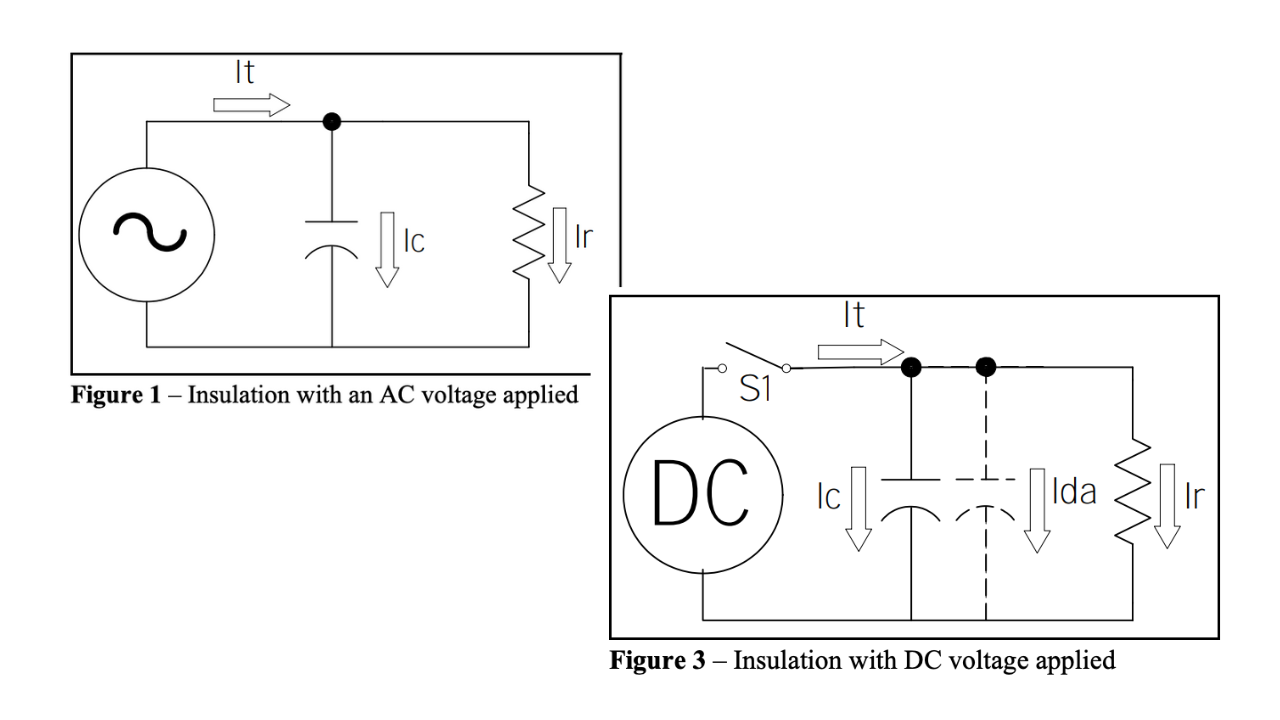
Principles of Insulation Testing
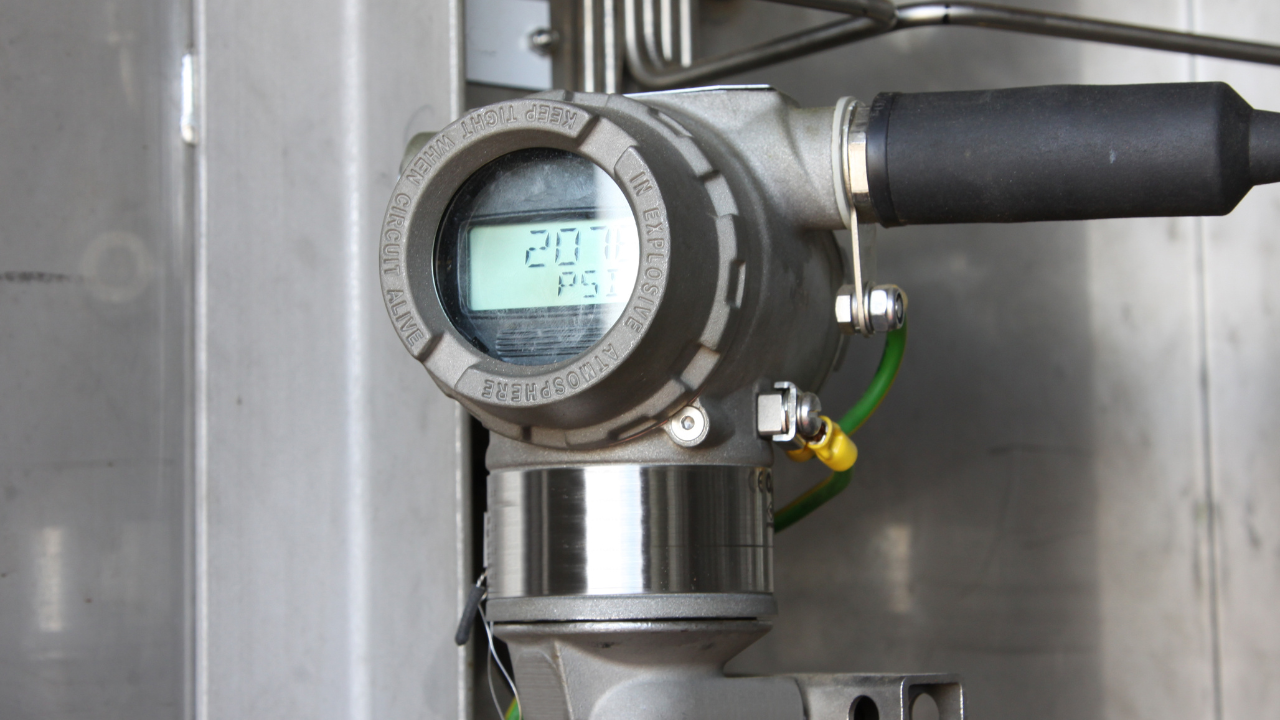
Top Tips for Selecting Pressure Measurement Transmitters
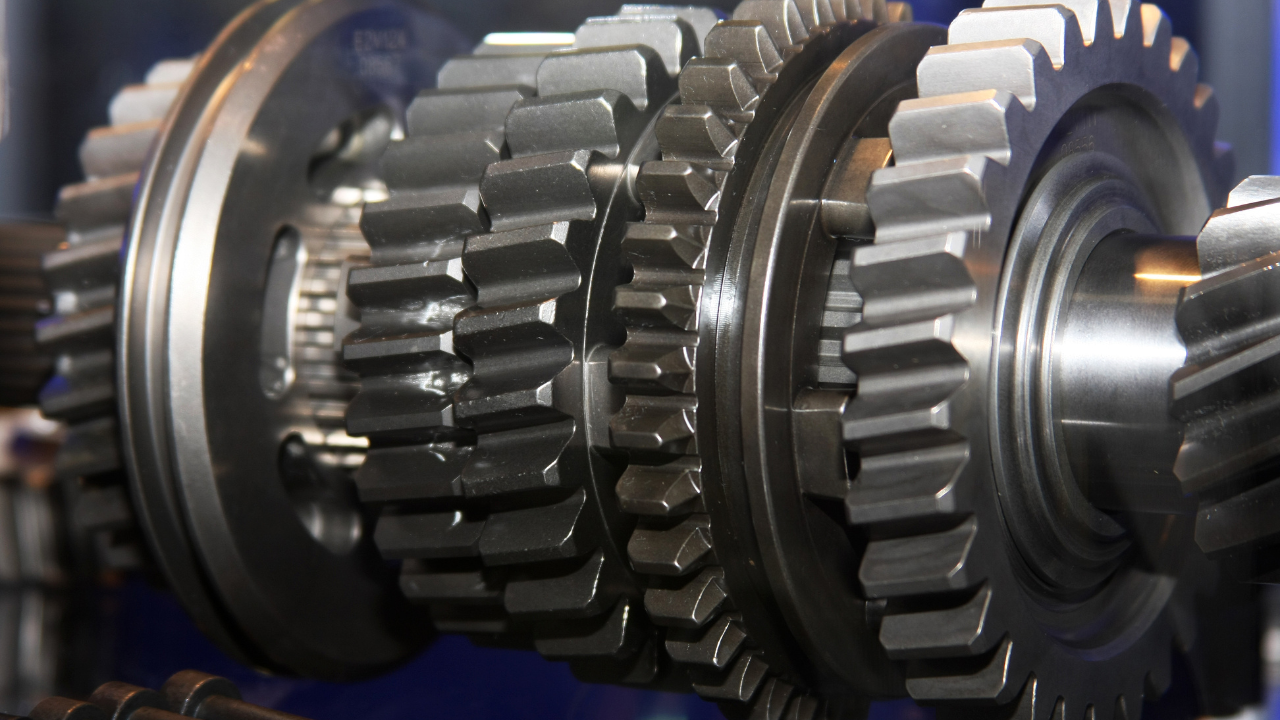
Gearbox Diagnostics Fault Detection
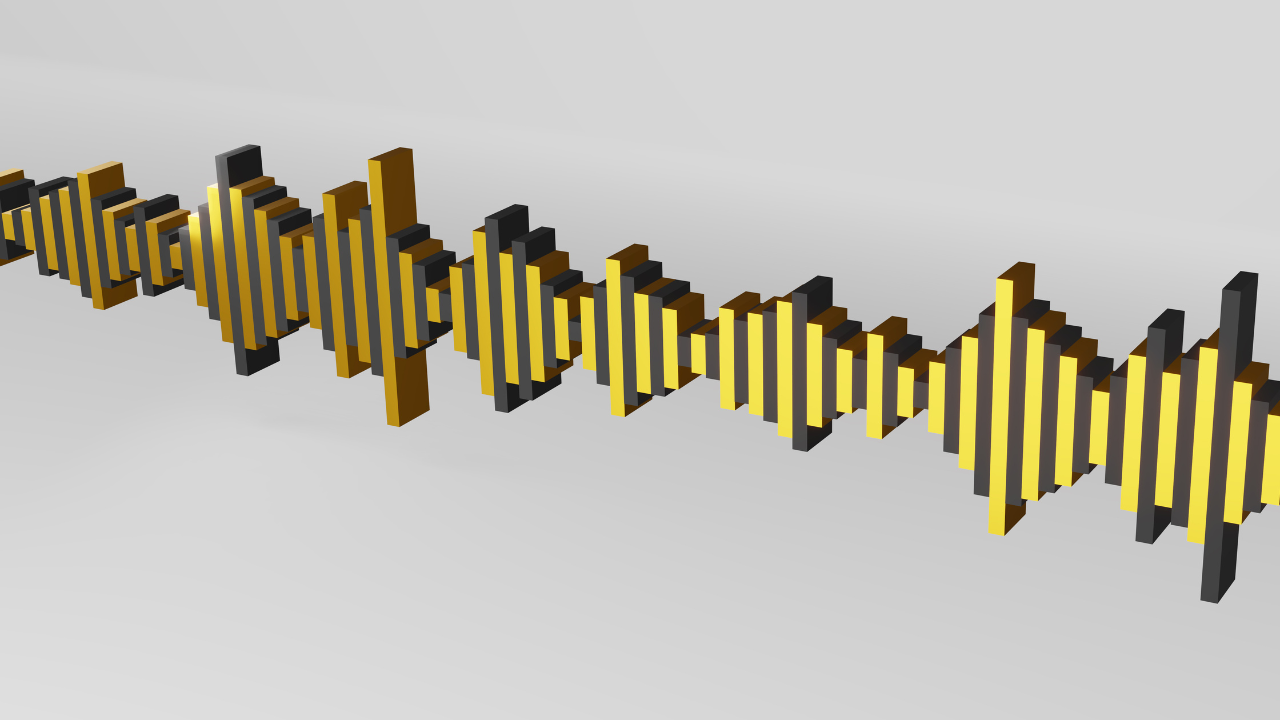
What is Vibration?

Why Record? Infrared Video
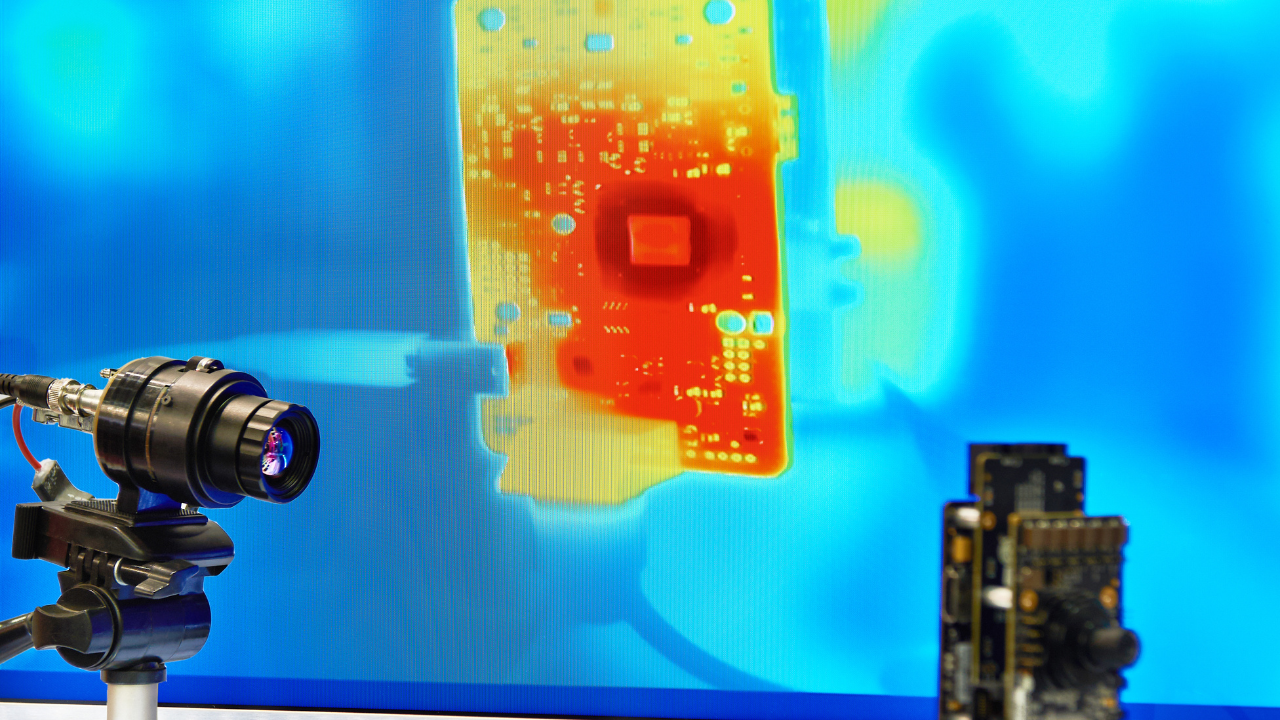
What You Should Know Before you Buy – A Guide to Buying an Infrared Camera





